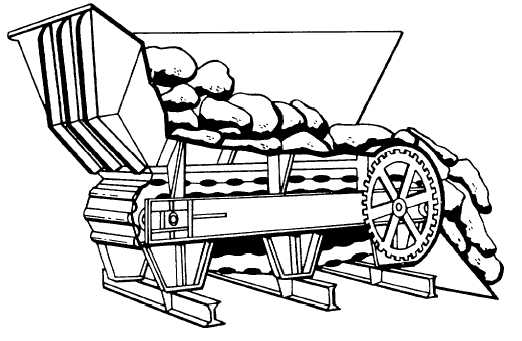Figure 6-3.-Apron feeder.
4. The gradation of raw material.
5. The extent of wear to the corrugated surfaces of
the jaw plates.
6. The rate of feeding.
Feeding problems may develop due to irregular
shapes and unwieldy nature of quarry run rock. Feeding
problems can drastically reduce production. Some
common problems are blocking, bridging, choking, and
packing.
Blocking occurs when an oversize rock settles over
the jaw opening and stops the flow of incoming material.
The jaw continues to operate but no crushing takes
place. To prevent blocking, you should let the maximum
size of material processed be 2 inches less than the jaw
crusher size. Blocking can be controlled or eliminated
by using a scalping grizzly to prescreen material. For
optimum production, the ideal feed size is 75 percent of
the jaw size.
Bridging occurs when two rocks, within the
maximum size, arrive at the same time. The two rocks
interlock and bridge the jaws open. When this occurs,
all production stops. When large rocks approach the
opening, they should be fed individually to prevent
bridging.
Choking
continually
occurs when the jaw chamber is
overfilled. This creates an overload
condition and causes the engine to lug down and may
damage the equipment. For optimum production, the
operator should try to keep the jaw chamber 75 percent
full.
Packing occurs when feed material cakes and packs
in the crusher chamber. Plastic material, such as clay,
may become sticky and cause this problem. Packing can
become so severe that it completely stops production.
Packing can be reduced or eliminated by prescreening
or prewashing the material. In most cases, the most
practical solution is to wet down the material
thoroughly. Then process the material even though it is
almost in the form of a slurry.
The jaw crusher can produce at a rate of 55 to 185
tph, depending upon the product setting and the
toughness of the material being crushed. The maximum
product setting is 5 inches, and the minimum setting is
1 1/2 inches.
WARNING
Keep all parts of your body out of the jaw
cavity when you are operating or adjusting the
jaws.
6-3


